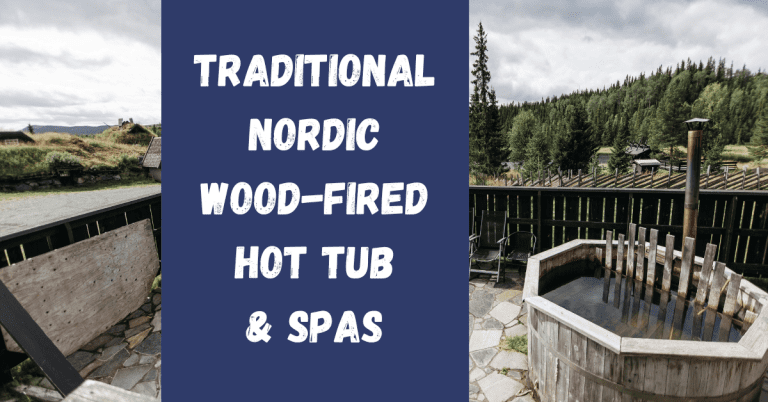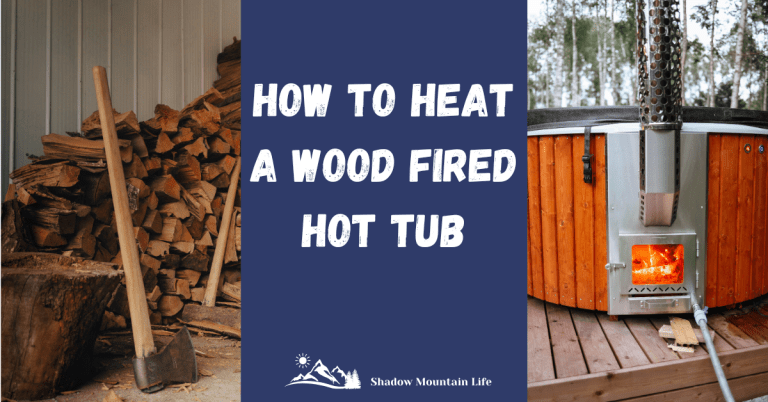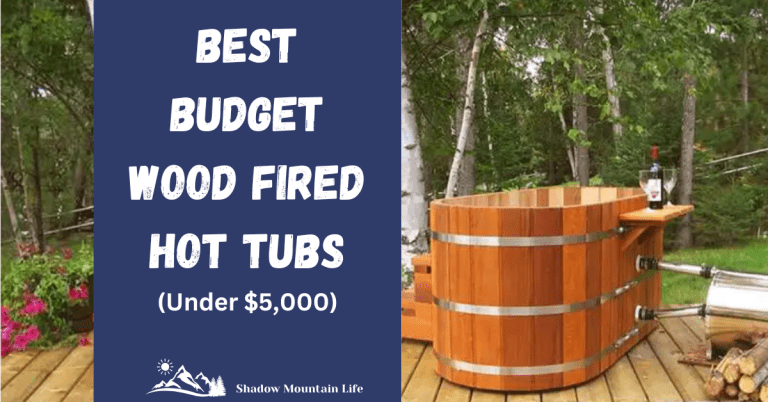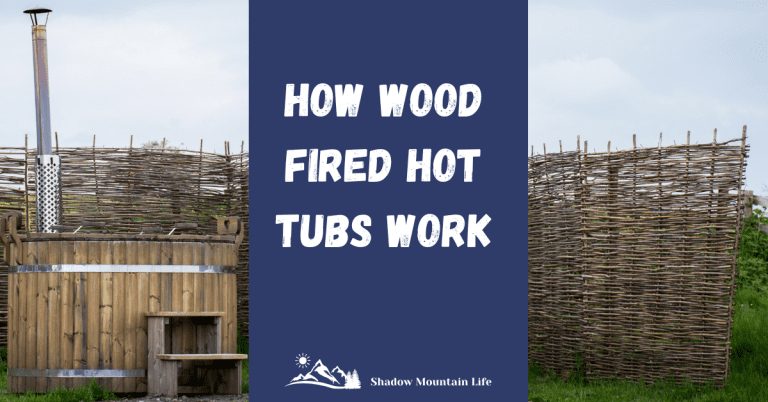Complete Guide to Wood Fired Hot Tubs: From Installation to Maintenance
Affiliate Disclaimer: We may make a commission if you purchase something through our links. Thank you!
While living in the mountains of Wyoming, a favorite winter activity of mine was visiting local hot springs and soaking in the warm water while the snow fell. Some of these hot springs were local tourist attractions while others were very remote requiring some serious trekking through the snow to reach.
I’ve never enjoyed standard hot tubs consisting of hard plastic and chlorine laced waters. I tend to come away feeling sick from the fumes with dried out and itchy skin. When I first heard about wood fired hot tubs, I was definitely intrigued to find a more natural way to soak!
If you are also looking for a more authentic and eco-friendly experience, wood fired hot tubs offer a perfect blend of tradition and luxury. Unlike conventional electric hot tubs that can cost upwards of $100 per month in energy bills, wood-fired tubs provide a sustainable, energy-independent solution. No electricity, no lights, no jets and fewer chemicals are needed.
Imagine placing your tub in the woods or near the beach with the stars bright above and the only sound the fire crackling in the stove…

Wood Fired Hot Tubs Gaining Popularity
The rise in popularity of wood fired hot tubs represents a significant shift in the luxury outdoor wellness market. With energy costs soaring and environmental consciousness at an all-time high, these traditional heating methods are seeing an increased interest among homeowners.
Recent market analysis shows a 47% increase in wood fired tub installations over the past two years, with cedar models leading the trend. While electric tubs still dominate the market, wood fired options are capturing an increasingly sophisticated segment of buyers who prioritize sustainability and authentic experiences over push-button convenience.
What is a Wood Fired Hot Tub?
Wood fired hot tubs are traditional soaking tubs that use a built-in wood burning stove or external firebox to heat the water, rather than relying on electricity like standard hot tubs. This heating method offers several benefits compared to modern electric models, including significantly reduced operating costs, a more authentic wellness experience, and a lower environmental impact.
Wood fired tubs come in two primary configurations – those with an internal stove and those with an external firebox. Internal stove models integrate the heating unit directly into the tub structure, allowing for a more compact and visually streamlined design.
External wood stoves have a firebox design that separates the heating element, typically housed in a weatherproof enclosure nearby, which can provide easier access for loading wood and cleaning.
Both options require a chimney or flue to safely vent smoke and fumes.
Our Top 5 Wood Fired Hot Tubs
- Best Overall: Backcountry Recreation Deluxe Wood Fired Hot Tub
- Best Small: Dundalk The Starlight Wood Burning Hot Tub
- Best Interior Stove: Sauna Life Wood Fired Hot Tub
- Best Large: Backcountry Recreation Deluxe Wood Fired Hot Tub XL
- Best External Stove: Kirami Classic by Almost Heaven
The Japanese Influence on Modern Wood Fired Tubs
Historical Context
The Japanese ofuro tradition dates back to the 17th century, when communal bathhouses became central to social life and wellness practices. Unlike Western bathing traditions focused on cleansing, Japanese soaking culture emphasized mental restoration and spiritual renewal.
This influence is evident in modern wood-fired tubs, which typically feature deeper soaking depths (26-32 inches) compared to conventional hot tubs (20-24 inches). The traditional ofuro design principles emphasized simplicity and connection with nature.

Key Japanese Design Elements
Modern wood-fired tubs incorporate several distinctive features from Japanese tradition. The standard 42-inch diameter allows for comfortable seating while maintaining the intimate feeling of traditional ofuro. Straight sides, rather than the curved designs common in Western tubs, promote better posture and a more meditative soaking experience.
Choosing the Right Wood: Cedar Hot Tub vs. Other Options
Cedar: The Gold Standard
Western Red Cedar has established itself as the premier choice for wood fired hot tubs, and for good reason. With natural oils that resist decay and repel insects, cedar tubs require minimal chemical treatment while maintaining their structural integrity. The wood’s cellular structure creates superior insulation, maintaining water temperatures up to 30% longer than other woods.
Premium cedar hot tubs from manufacturers like Kirami and Northern Lights typically range from $6,000 to $9,000, but their 15-20 year lifespan makes them a cost-effective long-term investment. The signature cedar aroma also adds an aromatherapy element to the soaking experience, though this gradually diminishes over time.
Scandinavian Thermowood
Scandinavian Thermowood is used in many wood burning hot tubs due to its strength and durability. Due to the high heat used to process the thermowood, it becomes resistant to insects and decay. Backcountry Recreation offers a variety of wood hot tubs in thermowood ranging from $5,000-$6,500 in cost.
While it may not have the scent and look of cedar, thermowood is a solid sustainable choice for your hot tub.
Hot Tub Optimal Placement and Installation Considerations
When deciding where to place your hot tub a number of things should be noted beforehand.
Site Selection
A level area measuring at least 12′ x 12′ provides adequate space for the tub, wood storage, and safe access. Key placement criteria include meeting minimum distance requirements from structures and property lines, as well as ensuring clear overhead space for the chimney with no power lines overhead.
Also, keep in mind that you will be more likely to use your tub if it is within a convenient distance from the house-especially in rainy or cold conditions!
Ground Preparation Specifications
Proper ground preparation is crucial for the long-term stability and safety of your tub. A 6-inch-thick concrete pad rated at 3000 PSI minimum is recommended, or a compacted 8-inch gravel bed can serve as an alternative foundation.
Be sure to provide a 1/4-inch per foot slope away from the tub for proper drainage into the ground and use gravel or sand to minimize mud.
Distance Requirements
The tub should be placed at least 10 feet from any main structures to meet typical fire safety codes. It should also be located at least 25 feet from property lines, though requirements may vary by jurisdiction.
Overhead clearance is important, with no power lines within 15 feet of the tub as well as low overhanging trees. The placement should also consider smoke direction to avoid disturbing neighboring properties.
Cost Breakdown for Site Preparation
Costs for site preparation vary greatly and depend on your personal circumstances, however, the list below gives a general idea of what you can expect to pay.
Preparing the site for a wood-fired hot tub can cost $1,500 to $3,200 on average. This includes $800-$1,200 for a professional concrete pad, approximately $400-$600 for a gravel bed, $200-$500 for a proper drainage system, and $500-$1,500 for any necessary landscape modifications.
Access and Utility Requirements
Water Source Planning
Proximity to a water source is important, with the ideal distance being within 50 feet. Filling the tub using a standard garden hose takes 45-60 minutes on average. For a more permanent solution, installing a dedicated water line can cost $300-$800.
If you want the tub away from the house, make sure to place it close to a river, lake or on a beach with close access for filling the tub by bucket.
Wood Storage Solutions
Proper wood storage is important for convenient operation. A covered area measuring at least 4′ x 4′ x 6′ is recommended to protect the wood from weather. Homeowners should plan for approximately 1/4 cord of wood per month of average use.
Dry split cordwood works well and burns quickly. Avoid wet soggy wood in your stove.

Wood Burning Hot Tub: Step-by-Step Heating Process
Initial Setup (2-3 hours before use)
The heating process begins with proper firebox preparation, a critical step that affects both heating efficiency and safety. Modern wood-fired tubs feature either internal or external fireboxes, with external models offering easier access but requiring more space. Regular duties include:
-Firebox inspection and ash removal
– Kindling arrangement using seasoned softwood
– Primary fuel loading with hardwood splits
– Water fill to recommended level
Making sure the water is filled to the recommended level before igniting the fire is very important as heating can damage your tub and elements if the water is not at the correct level.
Temperature Management
Achieving and maintaining optimal soaking temperature requires attention to detail and experience. Modern wood-fired tubs heat at approximately 20-25°F per hour, depending on ambient temperature and wood quality. The tub will also heat faster if you heat it with an insulated cover on top.
Some high-end models like the Snorkel H-3 ($8,900) feature integrated thermometers and advanced air flow controls for precise temperature management. You can also buy a simple floating thermometer to monitor your water temperature.
The optimal soaking temperature is usually between 100-104°F (38-40°C).
If you find the tub too hot simply add some cold water from the garden hose to reach your desired temperature.
Wood Fired Hot Tub Environmental Benefits vs. Electric Tubs
Energy Efficiency Comparison
Traditional electric hot tubs consume between 2,500-7,500 watts of electricity per day, resulting in annual operating costs of $1,000-$3,500 depending on local utility rates.
Wood fired tubs, by contrast, require no electricity for heating, reducing your carbon footprint by approximately 3-4 tons of CO2 per year.
Some premium models feature double-wall insulation that extends heat retention to 6-8 hours, requiring only 1-2 additional logs for temperature maintenance during extended soaking sessions.
Sustainable Operation Metrics
– Wood consumption: 25-30 pounds per 4-hour session
– Carbon neutrality potential with sustainably sourced wood
– Zero electromagnetic pollution
– Water consumption: 350-450 gallons per fill (40% less than typical electric tubs due to smaller capacity)
– Natural water treatment options using mineral-based systems ($150-200 annually) vs. chemical treatments ($300-500 annually)
Long-term Environmental Impact
Modern wood fired tubs last 15-25 years compared to 5-10 years for electric models, significantly reducing manufacturing and disposal impact. The Eco-Series by Northern Lights uses recycled materials for external components and locally sourced wood, further reducing the environmental footprint.
You will want to spend some time each year oiling the wood, but this is generally not a hard chore and keeps your tub looking nice.
Hot Tub Year Round Maintenance Guide
Spring (March-May)
– Deep cleaning and wood conditioning: 4-6 hours
– Drainage system cleaning
– Foundation inspection and repair
Summer (June-August)
– Weekly water quality monitoring
– Algae prevention in warmer temperatures
– Solar cover usage ($200-300) for temperature control
– Enhanced ventilation practices
Fall (September-November)
– Weatherproofing inspection
– Chimney/flue cleaning
– Wood storage preparation
– Insulation check and upgrade if needed
Winter (December-February)
– Freeze protection protocols
– Snow removal procedures
– Heated cover consideration
Safety Guidelines and Best Practices

Fire Management Safety
Modern wood fired tubs require specific safety protocols to prevent accidents and ensure optimal operation. Having the correct safety gear and protocols in place will help ensure a safe and comfortable experience.
A few things that are important to have nearby include heat-resistant gloves, a metal poker to move the logs, an ash bucket with a lid, and a fire extinguisher (Class A). It’s also a good idea to have a stocked first aid kit with burn treatment available.
Operating Safety Protocols
A few things to keep in mind include:
-Maximum water temperature should be no greater than 104°F (40°C) while enjoying the hot tub.
-Minimum water level requirements should be maintained at all times in the tub to prevent damage to the heating element and the tub itself.
-Be aware of the wind direction for smoke management on windy days.
-Quick drain system available in emergencies
Water Safety Management
Chemical Balance Monitoring
One of the best things about wooden hot tubs is that they require less chemicals to keep clean than regular hot tubs do. However, they do require some treatment. A weekly testing schedule is a good idea to keep the pH range between 7.2-7.8.
You will need to monitor the water quality of your tub to prevent bacteria and algae growth. You can either use chemicals like chlorine or bromine or look for a more natural saltwater-based system. Saltwater can help reduce inflammation in the body and is gentler on the skin than chlorine.
There is also the option of draining the tub after 2-3 times of use, however I would definitely recommend diverting the used water for re-use in your flowerbeds or garden if you choose this route to prevent wasting the water.
After draining your tub, simply wipe it down with some water and diluted bleach and the refill the tub.
Physical Safety Features
A few physical safety features to consider for your tub include non-slip steps or decking near the tub, lighting around the tub area and a cover with a lock for child safety.
My Top 5 Wood Fired Hot Tubs
1. Best Overall: Backcountry Recreation Deluxe Wood Fired Hot Tub
- Scandinavian Thermowood
- Dimensions 79″ external diameter, 35.5″ height
- Volume 300 US gallons
- Fiberglass liner for easy cleaning
- Seats 5-6 people
2. Best Small: Dundalk The Starlight Wood Burning Hot Tub
- Cedar Exterior with aluminum or plastic choice of interior
- Internal heater
- Roll up cover to keep debris out
- Dimensions 86″ x 45″ x 34″
- Seats 1 person comfortably, possibly 2
3. Best Interior Stove: Sauna Life Wood Fired Hot Tub
- Eco-Friendly Thermo-treated Spruce Wood
- Gray fiberglass interior for bather comfort
- Efficient stove heats water in 1/3 time of traditional stoves
- Dimensions 79″ exterior diameter and 37″ in height with volume of 304 Gallons
- Seats up to 6 people
4. Best Large: Backcountry Recreation Deluxe Wood Fired Hot Tub XL
- Scandinavian Thermowood Exterior
- Dimensions 89″ diameter, 37″ tall
- Volume 634 US Gallons
- Fiberglass liner for easy cleaning
- Seats 7-8 people
5. Best External Stove: Kirami Classic by Almost Heaven
- Premium cedar construction
- External firebox frees up space inside tub
- 6-8 Person Capacity
Why You Need a Wood Fired Hot Tub
Investing in a wood fired hot tub represents more than just a purchase – it’s an investment in a lifestyle that combines luxury with environmental consciousness. While the initial cost of $5,000-12,000 may seem substantial, the combination of minimal operating costs, environmental benefits, and potential 20+ year lifespan makes it an economically sound choice for many homeowners.
The ritual of preparing your tub becomes part of the wellness experience itself, offering a mindful approach to relaxation that’s increasingly rare in our automated world. As with a wood-burning sauna, you can be completely present and unplugged as you chop wood, feed the fire, and immerse yourself in the water.
For those considering this healthy investment, start by evaluating your space requirements, local regulations, and lifestyle needs. Canadian Western Red Cedar remains the top choice for most buyers, offering an optimal balance of durability and cost, though each wood type has its unique advantages and, in many cases, Thermowood is an equally good choice.
Remember that proper installation and consistent maintenance are crucial for longevity – budget approximately $500-800 annually for upkeep and wood.
Frequently Asked Questions
Q: Can I use my wood fired hot tub during power outages?**
A: Yes! This is one of the major advantages of wood fired hot tubs. Since they don’t rely on electricity for heating, they remain fully functional during power outages. You’ll only need minimal power (or battery-operated alternatives) for any optional features like LED lights or water circulation pumps. This makes wood tubs excellent for remote locations or as part of emergency preparedness planning.
Q: How long does it take to empty and refill a wood fired hot tub?
A: Emptying a wood-fired hot tub typically takes 30-45 minutes using a submersible pump, or 1-2 hours via gravity drain. Refilling takes 45-60 minutes with a standard garden hose. It’s recommended to clean and refill every 2-3 months with regular use, or more frequently during heavy use periods. Clean and refill after every 2-3 uses if not using chemicals in the water.
Pro tip: Use the drained water for garden irrigation. If you do use some chemicals in the water, avoid re-using the water on edible gardens.
Q: What happens if I need to leave the tub while it’s heating?
A: Modern wood fired tubs are designed with safety features that allow them to heat safely unattended. The key is proper fire management before leaving – ensure the firebox is loaded appropriately (not overfilled), air vents are set correctly, and the chimney is drawing properly.
Q: How do wood fired hot tubs perform in extreme weather conditions?
A: Wood fired tubs actually perform exceptionally well in extreme weather. In cold climates, they can maintain temperature even in sub-zero conditions, though heating times may increase by 25-40%. In hot climates, the design allows for better temperature control than electric tubs, as you can simply adjust the fire to maintain your desired temperature. Premium insulated covers ($300-500) are recommended for both extreme cold and hot climates to maintain efficiency. Many hot tub kits come with an insulated cover.







